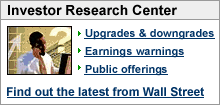|
Worried about the economy Rallying on mild inflation one day, slumping on weak growth the next, markets are on a roller coaster as investors try to guess how things will play out. NEW YORK (CNNMoney.com) -- Buckle up, investors. The economy could be in for a rough landing. Or not. Surging on signs of weaker inflation, slumping on hints of slower growth, one thing is clear: the stock market is freaked out about the economy, and not even this month's interest rate pause by the Federal Reserve may be able to ease the concerns.
Last week, the Nasdaq jumped more than 5 percent - its best five-day run since May 2003 - on a sell-off in oil prices and a pair of mild inflation reads. Why? Because the reports must mean that inflation is waning, like the Fed said it eventually would. And that must mean the economy is headed for a so-called soft landing. What a relief. On Wednesday, stocks withered after a read on existing home sales showed a steeper than expected slide in July. And on Thursday, stocks floundered after a new home sales report showed a similar setback. Why? Because if the housing market is collapsing at a faster pace than has been anticipated, that's going to slow the economy too much. Uh oh. Maybe the Fed tightened monetary policy so much it has nudged the economy into a recession. But neither scenario is a reality. Yet. It's just too early for stock investors and for the central bank to tell. On a day-to-day level, that means Wall Street is particularly sensitive to economic news and movements in the oil market, said Peter Dunay, investment strategist at Leeb Capital. The perception becomes that "if the daily numbers are lousy, we are in a bear market," said Dunay. "If the numbers are good, we're in a bull market." At the same time, he said, stocks have fluctuated for most of the year between roughly 1250 and 1325 on the S&P 500. So the swinging of bullish-to-bearish sentiment has had to play out within a very narrow range. Whether stocks can break out of that band by the end of the year is questionable, Dunay said, noting that "we're two-thirds of the way through the year and the S&P 500 is up less than 4 percent." Scale back on stocks? First American Funds recently cut its equity exposure to "neutral" from "overweight," saying it sees a weakening environment for stocks through the rest of the year. Among the reasons for the likely downturn, Keith Hembre, First American's chief economist, pointed to the disconnect between market expectations that the Fed is done raising rates and analyst expectations that the S&P 500 will still post double-digit earnings growth this year. "The environment in which you see earnings growth at that level is not consistent with the Fed keeping rates steady or lowering rates," Hembre said. "One has to give, either the earnings or the Fed," he added. "We think it will be the earnings, but neither is good for stock markets." Wal-Mart Stores, Toll Brothers and Dell are among the companies that have already warned about slowing earnings in the months ahead. Other developments Hembre said are bound to drag on stocks: nagging concerns about geopolitical events and their impact on oil prices; seasonal factors that make the fall months tough for bulls; the possibility of the traditionally big-business-friendly Republican Party losing one or both houses in Congress; and the cyclical economic risks that typically follow a period of Fed tightening. "Over the next six months, the economy will probably slow, earnings may disappoint and stocks may get clobbered," said Steven Goldman, market strategist at Weeden & Co. He said that some investors may want to shift their holdings into cash or other assets, but others may just want to make standard defensive play, such as putting money "into the most liquid, multi-national names they can." He said this would be a standard defensive move at this point in the economic and interest rate cycle. Donald Selkin, director of research at Joseph Stevens, said that he's not sure that stocks are in for such a ragged ride, pointing out that all three major gauges already saw steep declines following the April and May highs. Since then, stocks have bounced back and could just stall out through the rest of the year, even amid all the broader contingencies. "I think we'll go sideways to slightly up for the next couple of months and then late in the fourth-quarter we could maybe see the traditional rally," Selkin said, referring to the historical tendency for stocks to advance in November and December. High growth and low inflation are over The pause that doesn't refresh Worst of the worst of the worst |
|




